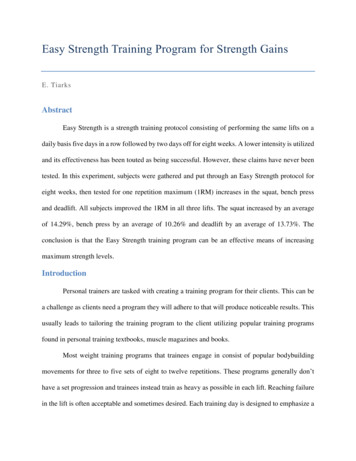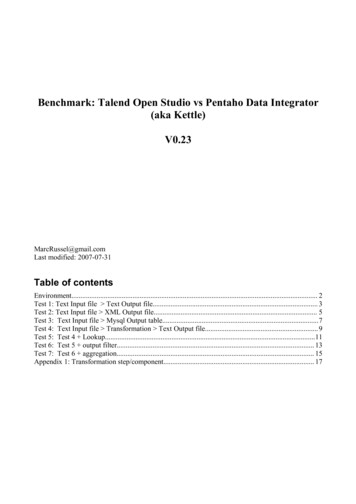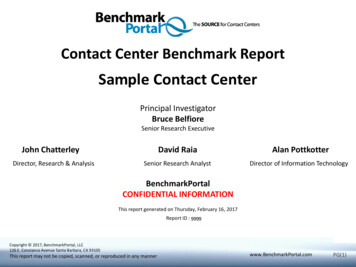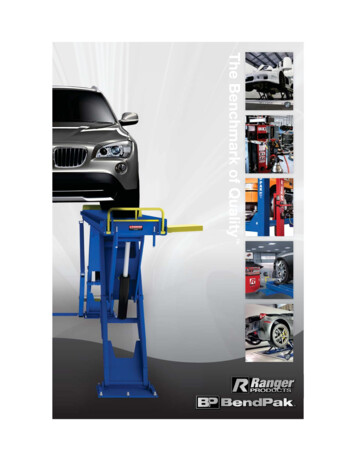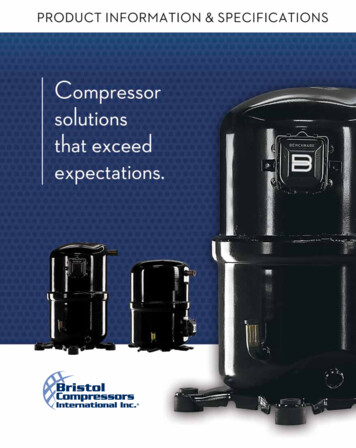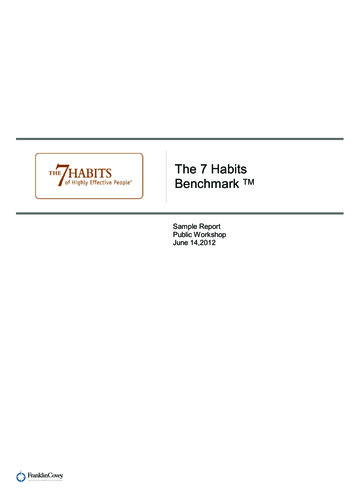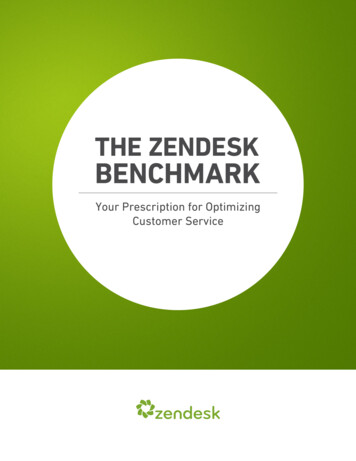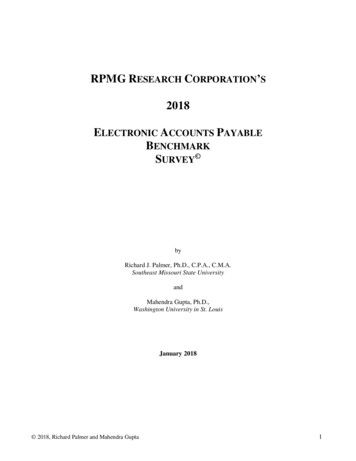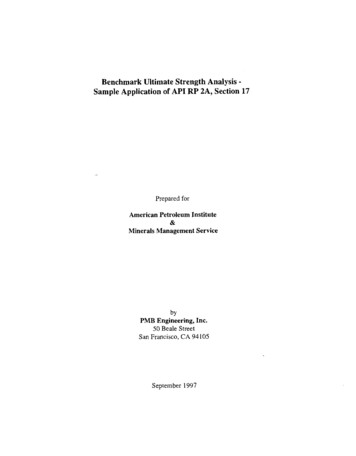
Transcription
Benchmark Ultimate Strength Analysis Sample Application of API RP 2A, Section 17Prepared forAmerican Petroleum Institute&Minerals Management ServicebyPMB Engineering, Inc.50 Beale StreetSan Francisco, CA 94105September 1997
PmBwm&wm&ForewordThis document was prepared under joint sponsorship of the Minerals Management Service(MMS) and the American Petroleum Institute [API) with technical direction provided by the APITask Group 10 (formerly called T 6 92-5).In December 1996, the API issued Supplement No. I to the Recommended Practice for Planning,Designing, and Constructing Fixed Offshore Platforms (API RP2A) [I] which included newguidelines for the assessment of existing structures. The guidelines, located in Section 17 of theAPI RP2A Supplement, include a consequence based assessment methodology which issignificantly different from conventional design. An example of these differences is the use ofnonlinear, ultimate strength, analysis to estimate the actual response of a platform to extrememetocean loadings as compared to linear elastic analysis with explicit and implicit safety factorsas applied in design.Prior studies that have applied the new assessment criteria [4] have indicated that there issignificant potential for variation in the analysis results depending upon the interpretation of theSection 17 guidelines as well as the specific modeling and analysis procedures. These studieshave shown that lack of familiarity with the assessment process is a significant contributor tovariability in results. This report has been developed to provide an illustrative example of thestructural modeling and application of Section 17 that can be used by engineers to become morefamiliar with the process and which also verifies software accuracy. This report compliments theguidelines and the commentary included in the Supplement as well as the technical papers thatwere written (and are shown as references in the Supplement) to provide background regardingthe development of the guidelines.The sample application which is provided in this report consists of a single Gulf of Mexicodrilling/production platform. The example platform includes a 4-leg jacket in a water depth of157 ft. The report includes all of the information that would be needed to perform a completeassessment of this platform (e.g., site conditions and physical conditions of the platform). Thereport also includes a description of an analysis methodology as well as the results which aregenerated from this methodology when using PMB's CAP computer software. It is not the intentof this document to endorse this particular analysis procedure or software or to make claimsregarding the benefit of a particular method or software over any other.This document does not provide a comprehensive discussion of analysis issues that one mayencounter with other applications of the Section 17 guidelines. It is not the intent of thisdocument to imply that the modeling and analytical procedures described herein are in any waygenerically applicable to any set of offshore platforms. This document address'es a number ofmodeling and analysis issues that are pertinent to this specific example. All other assessmentproblems (e.g., an 8 leg platform) will involve other modeling and analysis issues that are notdiscussed in this document. Therefore. the procedures discussed in this document must beconsidered as a example only and may not be suitable for any other application of the Section 17guideline.Benchmark Ultimate Capacity Analysis.11September 1997
ForewardIn addition to analysis results generated by PMB, a series of load and capacity data are alsoprovided that indicate the range of results that are considered, by the API Task Group, to bewithin the accuracy consistent with the basis of Section 17. These other results were generatedfrom the "Trials/Benchmark J I P [4,5,6] in which the example problem was analyzed by 13different organizations.Benchmark Ultimate Capacity Analysis.111September 1997
PYUBw"ContentsSectionPage.iiForewordList of 1:llustrations.viList of Tables . ix1Introduction.1-11.11.21.31.42Platform Details . 2-12.12.22.32.432-12-42-52-6API RP 2A-WSD 20th Edition Metocean Criteria . 3-1Applicable Section 17 Criteria . 3-4Model Development4.14.24.34.45Deck .Jacket .Pile Foundation .Soil.Metocean Criteria .3-13.13.24Section 17 Recommended Procedure for Platform Assessment . 1-1Background of the Benchmark JIP . 1-2Objectives of this Document . 1-3Use of this Document . 1-4.4-1Introduction .Basic Assumptions .Nonlinear Element Types .Wave Load Elements .4-14-14-24-5Metocean Loading .5-15.15.25.35.45.55.65.7Load Analysis Procedure . 5-1WaveICurrent Load Calculation Procedure . 5-2Wind Load . :. 5-3WaveICurrent Load on Jacket Structure . 5-4WaveICurrent Load on Deck . 5-4Summary of Load Analysis Results . 5-7Variations in JIP Participants' Results . 5-7Benchmark Ultimate Strength AnalysisSeptember 1997iv
PYHBm&ContentsSection6PageCapacity Analysis .6-1Introduction .Ultimate Strength Analysis .Base Case Capacity Analysis Results .Fixed Base Capacity Analysis Results .Variations in JIP Participants' Results .6.16.26.36.46.576-16-26-36-56-7Concluding Remarks .7-1.8References.8-1September 1997Benchmark Ultimate Strength Analysisv
ContentsLIST OF ILLUSTRATIONSFigures1-1Section 17 -Platform Assessment Process - Metocean Loading2-1Key Plan2-2Lower Deck Structural Details2-3Upper Deck Structural Details -Elevations and Plan at El 64'-4 314"2-4Upper Deck Structural Details-FramingPlan at El 56'-0 112".-2-5Upper Deck Structural Details -Framing Plan at El 7 1'-4 118"2-6Upper Deck Structure Modifications for New Gas Generator2-7Upper Deck Structure Extension for New Quarters2-8Stair Details - Upper Deck to Lower Deck2-9Stair Details - Lower Deck to Boat Landing2-10Deck Loading2-1 1Deck Elevations - Projected Areas2-12Jacket - Typical Elevation2- 13Jacket Horizontal Framing Elevation2-14Jacket Horizontal Framing Elevation -71'-0" thru -157'-0"2- 15Boat Landing Details (See Figure 2- 14 for Sections)2- 16Boat Landing and Barge Bumper Details2-17Pile Detail2-18Soil Strength Parameters 10'-0"thru -48'-0"September 1997Benchmark Ultimate Strength Analysisvi
PYHBWContentsLIST OF ILLUSTRATIONS (cont)Figures3- 1Wave Approach Directions3-2Region of Applicability of Extreme Metocean Criteria in API RP 2A,20th Edition3-3Guideline Omnidirectional Design Wave Height vs. MLLW,Gulf of Mexico, North of 27' N and West of 86' W3-4Guideline Design Wave Directions and Factors to Apply to theOmnidirectional Wave Heights (Figure 3-3), Gulf of Mexico,North of 27' N and West of 86' W3-5Guideline Design Storm Tide vs. MLLW, Gulf of Mexico,North of 27' N and West of 86' W3-6Guideline Design Current Direction (towards) with respect toNorth in Shallow Water (Depth 150 ft), Gulf of Mexico,North of 27'N and West of 86'W3-7Guideline Design Current Profile, Gulf of Mexico,North of 27" N and West of 86' W3-8Doppler Shift due to Steady Current3-9Full Population Hurricane Wave Height and Storm Tide Criteria3-10Full Population Deck Height Criteria4- 1Nonlinear Computer Model for Ultimate Capacity Analysis5-1Procedure for Calculation of Wave Plus Current Forcesfor Static Analysis5-2Regions of Applicability of Stream Function, Stokes V,and Linear Wave Theory5-3Shielding Factor for Wave Loads on Conductor Arraysas a Function of Conductor SpacingSeptember 1997Benchmark Ultimate Strength Analysisvii
ContentsLIST OF ILLUSTRATIONS (cont)Figures5-4Section 17 Wave-in-Deck Loads Computation Procedure6- 1Base Case Load - Displacement Behavior - Diagonal Storm6-2Inelastic Events at Stage I (per Figure 6- 1) - Diagonal Storm6-3Inelastic Events at Stage 2 (per Figure 6-1) - Diagonal Storm6-4Base Case Load - Displacement Behavior - Broadside Storm6-5Inelastic Events at Stage I (per Figure 6-4) -BroadsideStorm6-6Inelastic Events at Stage 2 (per Figure 6-4) -BroadsideStorm6-7Inelastic Events at Stage 3 (per Figure 6-4) -BroadsideStorm6-8Inelastic Events at Stage 4 (per Figure 6-4) -BroadsideStorm6-9Inelastic Events at Stage 5 (per Figure 6-4) -BroadsideStorm6-10Inelastic Events at Stage 6 (per Figure 6-4) -BroadsideStorm6-1 1Fixed Base Case Load - Displacement Behavior-6-1 2Inelastic Events at Stage 1 (per Figure 6-1 1) - Diagonal Storm6-13Inelastic Events at Stage 2 (per Figure 6-1 1)-6-14Inelastic Events at Stage 3 (per Figure 6-1 1) - Diagonal Storm6- 15Inelastic Events at Stage 4 (per Figure 6- 1 1) - Diagonal Storm6-16Inelastic Events at Stage 5 (per Figure 6- 1 1) - Diagonal Storm6- 17Inelastic Events at Stage 6 (per Figure 6- 1 1) - Diagonal Storm6-1 8Fixed Base Case Load - Displacement Behavior--Benchmark Ultimate Strength Analysis.VlllDiagonal StormDiagonal StormBroadside StormSeptember 1997
PmSContentsLIST OF ILLUSTRATIONS (cont)Figures6- 19Inelastic Events at Stage 1 (per Figure 6- 18) -Broadside Storm6-20Inelastic Events at Stage 2 (per Figure 6-18) -BroadsideStorm6-21Inelastic Events at Stage 3 (per Figure 6-1 8) -BroadsideStorm6-22Inelastic Events at Stage 4 (per Figure 6-1 8) -BroadsideStorm6-23Inelastic Eventsat Stage 5 (per Figure 6-18) -Broadside.-Storm6-24Inelastic Events at Stage 6 (per Figure 6- 18) -BroadsideStorm6-25JIP Results - Base Case Load-Displacement Results (End On Storm)6-26JIP Results - Base Case Load-Displacement Results (Diagonal Storm)6-27JIP Results - Base Case Load-Displacement Results (Broadside Storm)6-28JIP Results - Fixed Base Case Load-Displacement Results (End On Storm)6-29JIP Results - Fixed Base Case Load-Displacement Results (Diagonal Storm)6-30JIP Results - Fixed Base Case Load-Displacement Results (Broadside Storm)LIST OF TABLES5- 1Summary of JIP Results -Metocean LoadsBenchmark Ultimate Strength AnalysisSeptember 1997ix
Section 1Introduction1.1Section 17 Recommended Procedure for Platform AssessmentSection 17, which includes a recommended procedure for assessing existing platforms (Figure 1I ) , has been released as part of Supplement No. 1 to the API RP 2A, 20th edition [I, 31. Section17 provides guidelines for performing a fitness-for-purpose assessment of steel jacket platformsbased on their consequences of failure. It recommends a multi-stage assessment procedure forplatforms in U.S. waters, and the use of more sophisticated structural analysis methods todetermine the strength of platforms and their acceptability.The recommended procedure involves design level and ultimate strength analyses. The ultimatestrength analysis reduces conservatism and attempts to provide mean estimates of platformsystem (global) capacities using the best estimates of individual component (local) stiffnessesand capacities.-The loads (such as wave loading) used in an ultimate strength analysis are higher than those usedin the Section 17 design level analysis. The loads used in a Section 17 design level analysis aregenerally lower than those per Section 2 of API RP 2A for new structures.API Task Group 92-5, responsible for Section 17, developed the acceptance criteria byconsidering the historical experience of a large number of platforms subjected to extreme loadingduring the past 40 years. In general, less stringent criteria was recommended for older structuresbased on the consequences of loss of life and environmental pollution as a result of their failure.Specific economic risk from platform loss to the owner was not included in the criteriadevelopment. [2]Due to this new approach to platform assessment, two Joint Industry Projects (JIPs) wereundertaken during 1994 to perform trial applications of Section 17 to existing
generally lower than those per Section 2 of API RP 2A for new structures. API Task Group 92-5, responsible for Section 17, developed the acceptance criteria by considering the historical experience of a large number of platforms subjected to extreme loading during the past 40 years. In general, less stringent criteria was recommended for older structures based on the consequences of loss of .
